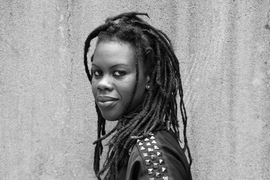Jay Scheib, professor of theater at MIT, directs “Bat Out of Hell,” a rock ’n’ roll musical based on Jim Steinman’s eponymous albums made famous by Meat Loaf. In December 2017, “Bat” received the London Evening Standard BBC Radio 2 Audience Award for Best Musical.
First written over 40 years ago, Steinman’s dystopian, futuristic adaptation of the Peter Pan and Wendy epic cuts in a bit of “West Side Story” and “Romeo and Juliet.” The musical follows Strat, the forever young leader of The Lost and his adventures in a post-apocalyptic Manhattan, now named Obsidian. When Raven, the daughter of Obsidian’s tyrannical ruler, Falco, falls in love with Strat the world comes unglued.
The musical premiered in Manchester, U.K. in February 2017, before opening in London in June. The production then moved to Toronto in October, where it ran through Jan. 7, 2018. It is now slated to return to London’s Dominion Theatre for an open-ended run beginning in April 2018. Scheib says a North American tour is also currently in discussion — with a Broadway run on the horizon.
Q: “Bat Out of Hell” has garnered a lot of positive press — much of it for the staging. The Manchester Evening News gave the show a five-star review, calling it “a truly staggering piece of musical theatre, which breaks new boundaries in its staging, choreography, and concept on an epic scale.” Paul Downham of North West End said, “this show has literally changed the way musicals are staged forever.” What boundaries were broken? What are some of the complexities to staging this show?
A: Those are thrilling claims. I would never make such claims about my own work, being from the Midwest, but I definitely was thrilled they did. We set out to work ahead of the rules — in the best circumstances, innovation results; that’s the challenge I always try to set for myself, staying in front of the rules, in an honest and committed way, and it usually pays off. I think the critics responded to the visceral quality of the work. We intend to leap off the stage, literally. The live cinema performance aspect is nothing new in my work and “Bat” goes the furthest in synthesizing many years of experimentation. It also opens new vistas. The use of camera allows us to see differently and to establish a level of intimacy usually reserved exclusively for the screen. Taken together, everything intensifies, everything is partially screened, and partially seen.
Q: What has the process been like, developing “Bat Out of Hell” with Jim Steinman?
A: I worked with Jim to develop the story and text — line by line, word by word, comma by comma. We would talk and then he would send me away to restructure scenes or rework dialogue and we’d discuss and we’d edit further and spend the nights typing and erasing. Jim’s insatiable but he’s also a night owl so I lost a lot of sleep that year.
The most thrilling task was in transforming these super iconic songs — most of which made famous by the singer Meat Loaf. Jim and I worked very hard to ensure that each song carried the action forward — much as though it were an opera. We spent a lot of time together, on the phone, in person when possible, via Skype. Jim still watches every single performance and sends me his notes and comments and suggestions for making improvements. It’s an ongoing process. It’s live.
Q: Is this also how you work with video?
A: Often technology and other aspects of the design don’t enter the room until the final stages of the process. That means that a lot of video design can feel decorative and not actually in dialogue with the work. Integrating these elements from the beginning is key. With “Bat Out of Hell” we had cameras, monitors, and sound equipment in the rehearsal room day one. Paulina Jurzec, who operated camera, was there from the beginning, developing camera moves in step with the staging of each scene.
Q: The show received the London Evening Standard Audience Award for Best Musical. What did you hope the audience experience would be like?
A: The aspect of the performance that I’m personally drawn to, and to which the whole mise-en-scène is really devoted, is rock ’n’ roll. And in this case it’s a rock ’n’ roll romance. I’m into the love story. I’m into doing “anything for love,” to quote one of the songs in “Bat.” People get hurt and in one tragic accident, die. Youth confront tyranny and run from the cops. Despots try and fail miserably to control their daughters. They fall in love. They fall more in love and gnash their teeth. They get on motorcycles and ride too fast and crash too hard. It’s mad-to-live madness in the spirit of punk. And if there is anything that I hope folks take away it is that it’s absolutely worthwhile to do anything for love — anything less is just less than rock ‘n’ roll.
The times feel uncertain. It would be naive to suggest that if you just fall in love and go for it, everything will be resolved. But on the other hand, the willingness to dare, to risk judgment and roll the dice on something you know and believe is true, emotionally, is valuable. It’s worth it.
The daring that goes into the Black Lives Matter movement and the #MeToo movement is a massive inspiration. That radical daring needs to go into the political situations that continually enrage us. Rock ’n’ roll is good at that, and that’s why it’s not just a good time. It’s also a way to unleash that celebratory energy that’s able to overcome all that threatens. It’s a rehearsal of the revolution.
Q: You’ve premiered a number of productions last fall — an opera at one of the German State Theaters in Wuppertal in September (Wagner’s “Götterdämmerung,” combined with Heiner Goebbels’ orchestral cycle “Surrogate Cities”), “Bat Out of Hell” in Toronto in October, then “Persona” in Los Angeles in November. Occasionally, MIT students have opportunities to work on certain aspects of faculty’s shows — designing new technologies or working with visiting artists. Has your recent work influenced your classes?
A: All three of those projects have shown up in the studio in recent years. Students worked on Peter Pan themes in 21M.645 (Motion Theater); strategies for live camera were explored in 21M.842 (Live Cinema Performance). Others participated in the development of the opera, “Persona,” which was composed by Professor Keeril Makan.
It’s valuable for our students to experience the transition from theory to practice in performance — it’s a real “mens-et-manus” approach to performance making. Unique situations and conditions arise that don’t otherwise exist in the studio. Many of the courses in Theater Arts are practice-based. The classroom is an extension of the studio, and for all of us, sharing the extension of our research from the lab to the field is unique at MIT.
Next semester, I’m developing an opera for the Royal Opera House in London, “Mamzer Bastard” by the Israeli composer Na’ama Zisser. We’ll be working on themes related to that production in the Live Cinema Performance class this spring, and I hope some students can join in that project in June in London. Several of the students came to see “Bat” in London last summer, and it was great to talk to them post-performance, to discuss their reactions, and introduce them to some of the producers, performers, and designers. It’s a great exchange, especially for the ones who want to push out into the field. It’s what I wish I had as an undergraduate! It feels vibrant, and it is.
Story prepared by SHASS Communications
Editorial team: Sharon Lacey and Emily Hiestand











